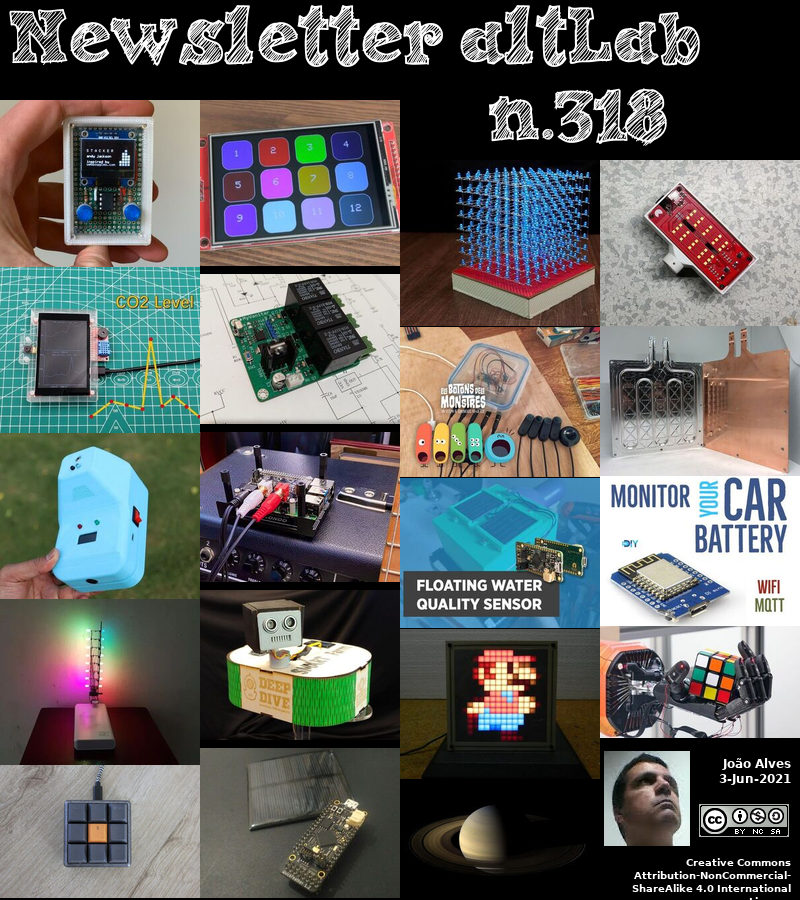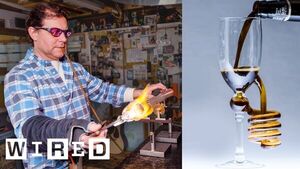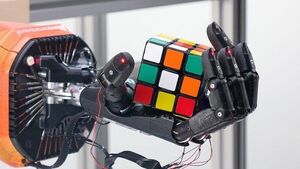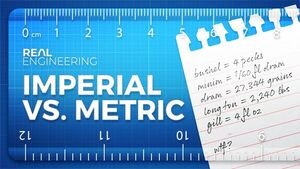2021-06-03 - Nº 318
Editorial
Esta é a Newsletter Nº 318 que se apresenta com o mesmo formato que as anteriores. Se gostar da Newsletter partilhe-a!
Todas as Newsletters encontram-se indexadas no link.
Esta Newsletter tem os seguintes tópicos:
Faz hoje anos que nascia, em 1659, o matemático e astrónomo escocês David Gregory. Ele publicou em 1702 o livro Astronomiae physicae et geometricae elementa, um esforço de popularização da ciência newtoniana. No entanto, na questão da aberração cromática, Gregory notou algo que Newton se tinha esquecido. Diferentes tipos de vidro espalham as cores do espectro em diferentes quantidades. Ele sugeriu que uma combinação adequada de dois tipos diferentes de vidro pode eliminar a aberração cromática. (Meio século depois, Dollond conseguiu esse resultado.) Os telescópios eram de seu interesse especial, e Gregory também fez experiências com a construção de um telescópio acromático. Gregory fez trabalhos importantes nas séries infinitas.
Faz tambḿe hoje anos que nascia, em 1777, o químico francês Charles Bernard Desormes. Ele colaborou com Nicolas Clément em investigações científicas, incluindo a determinação exacta da composição do monóxido de carbono e do dissulfeto de carbono. Eles também determinaram experimentalmente a proporção dos calores específicos dos gases (1819). Em trabalho independente, seguindo a pilha de Volta, Desormes concebe pilhas eléctricas secas compostas por discos metálicos separados por uma camada de pasta de sal (1801-04). Juntamente com Clement, Desormes estudou o calor e estimou grosseiramente o zero absoluto.
Faz igualmente hoje que nascia, em 1810, o sismólogo e engenheiro civil irlandês Robert Mallet. Ele começou a sua carreira em parceria com a fábrica de seu pai e, em poucos anos, envolveu-se em grandes projectos de engenharia. Sua primeira façanha foi levantar o telhado de 133 toneladas da Igreja de São Jorge em Dublin. Os seus interesses incluíam geologia física e ele escreveu vários artigos sobre terramotos de 1836 a 1879. Embora outros antes dele tenham atribuído os terramotos à vibração durante a passagem das ondas terrestres, Mallet estudou-os com mais detalhes, usando a abordagem de uma ciência exacta. Ele mediu a velocidade das ondas através da crosta terrestre, compilou um catálogo de terramotos registados e apresentou um mapa sísmico do mundo. Desde que ele cunhou o termo, ele pode realmente ser chamado de o primeiro sismólogo e pai dessa ciência.
Por fim, faz hoje anos que nascia, em 1864, o inventor e fabricante de automóveis americano Ransom E. Olds. Ele foi o projectista do Oldsmobile de três cavalos de força e traços curvos, o primeiro automóvel americano de sucesso comercial e o primeiro a usar um sistema de montagem progressivo, que antecipava os métodos modernos de produção em massa. Em 1887, numa distância de um quarteirão, Olds dirigiu o primeiro automóvel de Lansing, um veículo experimental a vapor. Ele continuou a trabalhar com vapor, gasolina e energia eléctrica. Eventualmente, ele produziu um veículo movido a gasolina que acomodava quatro pessoas e podia fazer 18 milhas por hora em terreno plano.
Em 1965 a cerca de 193 Km acima da Terra, o Major Edward H. White II abre a escotilha do Gemini 4 e sai da cápsula, tornando-se o primeiro astronauta americano a caminhar no espaço. Preso à nave por uma corda de 25 pés e controlando seus movimentos com uma pistola de propulsão a jacto de oxigénio, White permaneceu fora da cápsula por pouco mais de 20 minutos. Como um viajante espacial, White foi precedido pelo cosmonauta soviético Aleksei A. Leonov, que em 18 de Março de 1965 foi o primeiro homem a caminhar no espaço.
Nesta semana que passou foi inaugurado o cabo submarino EllaLink que liga Portugal ao Brasil. O EllaLink é a primeira ligação directa de alta velocidade por cabo submarino entre a Europa e a América do Sul.
Na Newsletter desta semana apresentamos diversas noticias, artigos científicos, projetos de maker assim como alguns videos interessantes.
 João Alves ([email protected])
João Alves ([email protected])
O conteúdo da Newsletter encontra-se sob a licença  Creative Commons Attribution-NonCommercial-ShareAlike 4.0 International License.
Creative Commons Attribution-NonCommercial-ShareAlike 4.0 International License.
Novidades da Semana

Portugal inaugurates undersea cable
"The Portuguese Presidency of the Council of the European Union (EU) is inaugurating on 1 June, in Sines, the ‘EllaLink’ undersea optical cable, which links Europe to South America and will be “essential” for the digital interconnection of the continents. The ‘EllaLink’, which is the first direct high-speed link by submarine cable between Europe and South America, is considered by the Portuguese presidency to be “an essential infrastructure for the digital interconnection and transmission of data between the two continents”. The inauguration ceremony, scheduled for 10:50am, will take place in a hybrid format (in person and online) from Sines, where the cable will be anchored, with a connection to Fortaleza (Brazil), and will be presided over by Prime Minister António Costa. The event will also include interventions, by videoconference, of the UN Secretary-General, António Guterres, the President of the European Commission, Ursula von der Leyen, and the President of the European Parliament, David Sassoli. The inauguration of ‘EllaLink’ is part of the ‘Leading the Digital Decade’ event, co-organised by the Portuguese Presidency and the European Commission, with the presence of representatives of “several EU Member States, representatives of the European Parliament and the European Commission, as well as representatives of the private sector and civil society”. The two-day meeting aims to “promote a wide debate around the digital transformation of the EU”, based on the objectives of the Digital Decade, an initiative presented by the Commission in March to ensure that all European citizens can benefit from digital." [...]
Outras Notícias
Raspberry Silicon update: RP2040 on sale now at $1
"Back in January, we launched Raspberry Pi Pico. This was a new kind of product for us: our first microcontroller-class board, and the first to be built on RP2040, a chip designed here at Raspberry Pi. At the same time, we announced RP2040-based products from our friends at Adafruit, Arduino, Sparkfun, and Pimoroni. Today, we’re announcing the logical next step: RP2040 chips are now available from our Approved Reseller partners in single-unit quantities, allowing you to build your own projects and products on Raspberry Silicon. RP2040: the microcontroller, perfected RP2040 is our idea of the perfect mid-range microcontroller, based on years of using other vendors’ devices in our own products and projects. It stands out in three key ways: - Two fast CPU cores." [...]

NASA’s Curiosity Rover Captures Shining Clouds on Mars
"The science team is studying the clouds, which arrived earlier and formed higher than expected, to learn more about the Red Planet. Cloudy days are rare in the thin, dry atmosphere of Mars. Clouds are typically found at the planet’s equator in the coldest time of year, when Mars is the farthest from the Sun in its oval-shaped orbit. But one full Martian year ago – two Earth years – scientists noticed clouds forming over NASA’s Curiosity rover earlier than expected. This year, they were ready to start documenting these “early” clouds from the moment they first appeared in late January. What resulted are images of wispy puffs filled with ice crystals that scattered light from the setting Sun, some of them shimmering with color." [...]

Samsung Introduces Its First ZNS SSD With Maximized User Capacity and Enhanced Lifespan
"Maximum available storage capacity and 3-4x longer lifespan enable server systems to run big data and AI applications more reliably and efficiently Samsung Electronics, the world leader in advanced memory technology, today unveiled its new enterprise solid-state drive (SSD) featuring Zoned Namespace (ZNS) technology — the PM1731a. Leveraging ZNS, the SSD will maximize available user capacity and offer an extended lifespan in storage server, data center and cloud environments. “Samsung’s ZNS SSD reflects our commitment to introducing differentiated storage solutions that can substantially enhance the reliability and lifetime of server SSDs,” said Sangyeun Cho, senior vice president of the Memory Software Development Team at Samsung Electronics. “We plan to leverage quad-level cell (QLC) NAND technology in our next-generation ZNS drives to enable higher thresholds for storage performance and capacity in the enterprise systems of tomorrow.” ZNS allows data to be grouped based on their usage and access frequency, and stored sequentially in independent zones within an SSD. Without the need to move and rearrange data, ZNS SSDs can significantly reduce the number of write operations, lowering the drive’s write amplification factor (WAF) — the amount of actual writes performed by the drive compared to writes initially instructed by the host system. The closer the WAF is to one, the more efficient the SSD and the longer it will last." [...]
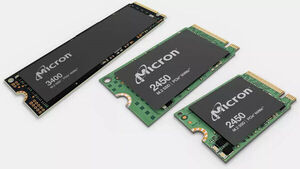
Micron Accelerates Breakthrough Platform Innovation With Advancements Across Industry’s First 176-Layer NAND and 1-Alpha DRAM
"Micron Technology, Inc. (Nasdaq: MU), today unveiled memory and storage innovations across its portfolio based on its industry-leading 176-layer NAND and 1α (1-alpha) DRAM technology, as well as the industry’s first Universal Flash Storage (UFS) 3.1 solution for automotive applications. The new portfolio additions deliver on the company’s vision of accelerating data-driven insights through innovations in memory and storage that enable new capabilities from the data center to the intelligent edge. Micron President and CEO Sanjay Mehrotra made the announcements during a Computex keynote, in which he shared a sweeping vision for computing innovation and the central role memory and storage play in enabling enterprises to seize the full potential of the data economy. Micron announced volume delivery of its first PCIe® Gen4 solid-state drives (SSDs) built with the world’s first 176-layer NAND. The company is also shipping the world’s first 1α node-based LPDDR4x DRAM this month. LPDDR4x is the latest JEDEC specification for fourth-generation low-power DRAM with improved input/output voltage for substantially lower power, making it ideal for mobile computing devices." [...]

World’s Best Processor for Thin-and-Light Windows Laptops Just Got Better
"Today at Computex 2021, Intel announced two new additions to the lineup of 11th Gen Intel® Core™ processors. These new processors, combined with Intel's co-engineering work with independent software vendors (ISVs) and original equipment manufacturers (OEMs), continue Intel’s leadership in mobile compute — delivering the world’s best processors for thin-and-light Windows-based laptops.1 Intel also introduced its first 5G product for the next generation of PC experiences, Intel® 5G Solution 5000, following the previously announced collaboration with MediaTek and Fibocom. Why It Matters: Widespread pandemic-driven requirements for working and studying at home have proven that mobility, performance and connectivity are essential to modern PC experiences. As the world embarks on the next stages of hybrid work-learn-play models, advancements in mobile computing support the evolution of how and where people use their devices. About the New 11th Gen Intel Core Processors: The 11th Gen Intel Core processor family continues to deliver real-world productivity, collaboration, creation, gaming and entertainment on thin-and-light laptops. Now 11th Gen Intel Core processor-based laptops2 deliver: Up to 5 gigahertz (GHz) in high-volume thin-and-light designs — an industry first." [...]

AMD Unveils RDNA 2-Based Mobile Graphics, New AMD Advantage Laptops, Broadly Compatible Upscaling Technology and More at Computex 2021
"Today at Computex 2021 AMD (NASDAQ: AMD) introduced several powerful new solutions that take high-performance gaming to new levels. Designed to bring world-class performance, incredible visual fidelity and immersive experiences to gaming laptops, the new AMD Radeon™ RX 6000M Series Mobile Graphics include the top-of-stack Radeon RX 6800M – the fastest AMD Radeon GPU for laptops1, delivering desktop-class performance2 to power ultra-high frame rate 1440p gaming anywhere. AMD also introduced theAMD Advantage™ Design Framework, the result of a multi-year collaboration between AMD and its global PC partners to deliver the next generation of premium, high-performance gaming laptops. Combining AMD Radeon RX 6000M Series Mobile Graphics, AMD Radeon Software and AMD Ryzen™ 5000 Series Mobile Processors with exclusive AMD smart technologies and other advanced system design characteristics, AMD Advantage systems are designed to deliver best-in-class gaming experiences. The first AMD Advantage laptops are expected to be available from leading OEMs beginning this month. In addition, AMD unveiled AMD FidelityFX Super Resolution (FSR), a cutting-edge spatial upscaling technology designed to boost framerates up to 2.5X in select titles at 4K resolution3 and deliver a high-quality, high-resolution gaming experience." [...]

Microsoft acquires ReFirm Labs to enhance IoT security
"Modern computing devices can be thought of as a collection of discrete microprocessors each with a dedicated function like high-speed networking, graphics, Disk I/O, AI, and everything in between. The emergence of the intelligent edge has accelerated the number of these cloud-connected devices that contain multiple specialized sub-processors each with its own firmware layer and often a custom operating system. Many vulnerability analysis and endpoint detection and response (EDR) tools find it challenging to monitor and protect devices at the firmware level, leading to an attractive security gap for attackers to exploit. At the same time, we have also seen growth in the number of attacks against firmware where sensitive information like credentials and encryption keys are stored in memory. A recent survey commissioned by Microsoft of 1,000 security decision-makers found that 83 percent had experienced some level of firmware security incident, but only 29 percent are allocating resources to protect that critical layer. And according to March 2021 data from the National Vulnerability Database included in a presentation from the Department of Homeland Security’s Cybersecurity and Infrastructure Agency (CISA) at the 2021 RSA, difficult-to-patch firmware attacks are continuing to rise." [...]
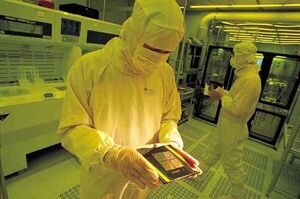
NXP Ramps Automotive Processing Innovation with Two Processors on TSMC 16nm FinFET Technology
"NXP Semiconductors N.V. (NASDAQ: NXPI), a world leader in automotive processing, and TSMC (TWSE: 2330, NYSE: TSM) today announced the release of NXP’s S32G2 vehicle network processors and the S32R294 radar processor into volume production on TSMC’s advanced 16 nanometer (nm) FinFET process technology. This marks the migration of NXP’s S32 family of processors to increasingly advanced process nodes as automobiles continue to evolve into powerful computing platforms. NXP’s continued innovation in the S32 family is designed to help carmakers simplify vehicle architecture and deliver the fully connected and configurable car of tomorrow. The S32G2 vehicle networking processors enable service-oriented gateways for secure cloud connectivity and over-the-air updates that will unlock a multitude of data-driven services such as usage-based insurance and vehicle health management. S32G2 processors also serve as domain and zonal controllers to enable next-generation vehicle architectures and as high-performance ASIL D safety processors in advanced driver assistance and autonomous drive systems. The move to TSMC’s 16nm technology has allowed S32G2 to consolidate multiple devices into one, creating a powerful System-on-Chip (SoC) that reduces the processor’s footprint." [...]

Toshiba’s Triple-Gate IGBT Power Semiconductors Cut Switching Power Losses by 40.5%
"Toshiba Corporation (TOKYO: 6502) has developed a prototype triple-gate IGBT*1 that reduces overall power loss by up to 40.5% when switching on and off (switching losses), the process of allowing and stopping electricity flow, in power semiconductors used to control electric power. It is difficult to reduce power loss in IGBT, due to a trade-off whereby reducing the loss when the IGBT is on (conduction losses) increases switching loss. Toshiba took on this problem by developing a silicon IGBT with a new structure of three gate electrodes and gate control technology that delivers high accuracy gate electrode switching. The new device reduces turn-on loss*2 by 50% and turn-off loss*3 by 28%, an overall reduction of up to 40.5% against a conventional single-gate electrode IGBT, with no increase in conduction losses. Improving the energy efficiency of power semiconductors is seen as essential for realizing carbon neutrality, particularly by achieving higher efficiency IGBT, power semiconductors used in many products and equipment. The new technology is expected to boost the efficiency of power converters in electrical systems, including renewable energy systems, electric vehicles, railroads, and industrial equipment." [...]

STMicroelectronics First to Announce Certified Chipset for G3-PLC Hybrid Powerline and Wireless Communication
"Turn-key solution based on field-proven ST8500 programmable multi-protocol SoC and ultra-low-power sub-GHz S2-LP RF transceiver STMicroelectronics’ ST8500 and S2-LP chipset has become the first to be certified according to the G3-PLC Hybrid communication standard that defines seamless connectivity over powerline and wireless media. The G3-PLC Hybrid specification allows smart-grid, smart-city, industrial, and IoT equipment to select the best available wireless or powerline channel at any time, automatically and dynamically, according to network conditions. This enables superior coverage, reliability, and scalability, while also allowing cost-efficient system operation and enabling new use cases. One of the world’s first Hybrid-ready solutions, ST demonstrated its ST8500 Hybrid chipset at a G3-PLC Alliance interoperability plugfest in 2020. The chipset is now the first to complete the latest G3-PLC certification scheme, published in March 2021, which incorporates the Hybrid profile tests. The certified chipset combines the ST8500 programmable multi-protocol powerline communication system-on-chip (SoC) and STLD1 line driver with the Company’s S2-LP ultra-low-power sub-GHz radio transceiver." [...]

Nordic launches Apple Find My network compatible Software Development Kit
"Nordic SDK supports design of Bluetooth Low Energy Find My-enabled products such as Belkin’s SOUNDFORM Freedom wireless earbuds and the Chipolo ONE Spot item finder Nordic Semiconductor today announces the availability of its ‘Apple Find My network compatible Software Development Kit (SDK)’. The SDK enables customers to easily build Find My network capable Bluetooth® Low Energy (Bluetooth LE) devices that maximize battery performance with Nordic’s nRF52 Series System-on-Chip's (SoC) ultra low power consumption. The Find My network accessory program opens up the private and secure Find My network to third-party device manufacturers to build products utilizing the service, so their customers can use the Find My app to locate and keep track of the important items in their lives. “The Apple Find My network delivers a solution for helping consumers keep track of their important devices while fully protecting the owner’s privacy,” comments Pär Håkansson, Nordic’s Product Manager for Short Range IoT. “With Nordic’s SDK, developers can create products which take advantage of the powerful Find My network. The end-products become part of the Apple ecosystem which ensures vast tracking coverage and helps consumers find their devices more easily.” “While finding solutions have been on the market for a while, the Find My network’s enhanced privacy and global coverage, made up of hundreds of millions of Apple devices, makes this sector an even better prospect for manufacturers." [...]
Ambarella, Lumentum and ON Semiconductor Collaborate on AI Processing Based 3D Sensing for Next-gen AIoT Devices
"Ambarella, Inc. (NASDAQ: AMBA), an AI vision silicon company, Lumentum (NASDAQ: LITE), a market-leading designer and manufacturer of innovative optical and photonic products, and ON Semiconductor® (NASDAQ: ON), a leading provider of CMOS image sensor solutions, today announced two new joint reference designs that accelerate AIoT device deployment across verticals, building on the companies’ previous joint solution for contactless access systems. By combining the data from Lumentum’s high-performance VCSEL array illuminators and an ON Semiconductor image sensor using Ambarella’s AI SoC, higher levels of accuracy and more intelligent decision-making can be achieved in next-generation AIoT devices for biometric access control, 3D electronic locks and other intelligent sensing applications. Originally intended for biometric access control and electronic locks, these new reference designs can also address the needs of smart cities, smart buildings, smart homes and intelligent healthcare. Additionally, the high level of integration provided by these joint solutions significantly lowers system power consumption and thermal design requirements while enabling much smaller product form factors. “Ambarella’s vision is to combine AI processing with 3D and vision sensing to create an ambient intelligent future,” said Fermi Wang, President and CEO of Ambarella. “This collaboration with Lumentum and ON Semiconductor will further advance the convergence of AI and IoT to enable a new generation of access control systems, while inspiring novel categories of ambient sensing products—all powered by the fusion of sensors using AI vision processors that interact intelligently and unobtrusively with people to address their ever-evolving needs.” “Our new joint solutions will greatly increase the accuracy of AIoT devices across application verticals—starting with biometric access control and electronic locks—enabling them to recognize people and predict their needs, rather than requiring a direct human interface,” said Téa Williams, Senior Vice President and General Manager, 3D Sensing of Lumentum." [...]
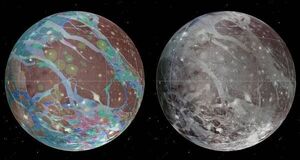
NASA’s Juno to Get a Close Look at Jupiter’s Moon Ganymede
"On Monday, June 7, at 1:35 p.m. EDT (10:35 a.m. PDT), NASA’s Juno spacecraft will come within 645 miles (1,038 kilometers) of the surface of Jupiter’s largest moon, Ganymede. The flyby will be the closest a spacecraft has come to the solar system’s largest natural satellite since NASA’s Galileo spacecraft made its penultimate close approach back on May 20, 2000. Along with striking imagery, the solar-powered spacecraft’s flyby will yield insights into the moon’s composition, ionosphere, magnetosphere, and ice shell. Juno’s measurements of the radiation environment near the moon will also benefit future missions to the Jovian system. Ganymede is bigger than the planet Mercury and is the only moon in the solar system with its own magnetosphere – a bubble-shaped region of charged particles surrounding the celestial body. “Juno carries a suite of sensitive instruments capable of seeing Ganymede in ways never before possible,” said Juno Principal Investigator Scott Bolton of the Southwest Research Institute in San Antonio." [...]
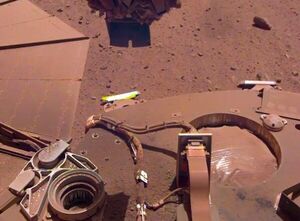
NASA’s InSight Mars Lander Gets a Power Boost
"The spacecraft successfully cleared some dust off its solar panels, helping to raise its energy and delay when it will need to switch off its science instruments. The team behind NASA’s InSight Mars lander has come up with an innovative way to boost the spacecraft’s energy at a time when its power levels have been falling. The lander’s robotic arm trickled sand near one solar panel, helping the wind to carry off some of the panel’s dust. The result was a gain of about 30 watt-hours of energy per sol, or Martian day. Mars is approaching aphelion, its farthest point from the Sun. That means less sunlight reaches the spacecraft’s dust-covered solar panels, reducing their energy output." [...]

Galileo satellites’ last step before launch
"Europe’s Galileo satellite navigation constellation is set to grow. Later this year the first two out of 12 ‘Batch 3’ Galileo satellites will be launched by Soyuz from French Guiana. Their last step on the way to launch is situated beside sand dunes on the Dutch coast: the ESTEC Test Centre, which is Europe’s largest satellite test facility. All but two of the 26 Galileo satellites already in orbit underwent pre-flight testing at this 3000 sq. m environmentally-controlled complex, hosting test equipment to simulate all aspects of spaceflight. The Test Centre is operated and managed by European Test Services for ESA." [...]

SpaceX launches new solar arrays to space station, nails rocket landing at sea
"SpaceX launched its 17th rocket of the year today (June 3), sending a robotic Dragon cargo capsule toward the International Space Station before nailing a landing at sea. A two-stage Falcon 9 rocket blasted off from Pad 39A here at NASA’s Kennedy Space Center at 1:29 p.m. EDT (1729 GMT), kicking off the company's 22nd resupply mission to the orbiting lab for NASA. The Dragon is packed with more than 7,300 lbs. (3,311 kilograms) of supplies, scientific experiments and hardware, including two new solar arrays for the space station's power grid. Approximately 9 minutes after liftoff, the Falcon 9's first stage returned to Earth, landing on one of SpaceX's drone ships in the Atlantic Ocean in a smooth touchdown. The massive ship, called "Of Course I Still Love You," is one of two in the company’s fleet of recovery vessels that catch falling boosters and return them to port for later reuse." [...]
Ciência e Tecnologia

Ultrasonic Welding Makes Parts for NASA Missions, Commercial Industry
"A manufacturing innovation that has applications for NASA spacecraft is being transferred to the private sector to support a variety of industries here on Earth. A burst water main is always expensive and messy, but a pipe that fails in space can be mission-ending. That’s why NASA technologists work hard to make hardware as reliable as possible. Sometimes that means scrapping the old way of doing things and experimenting with a brand-new material – or fabrication process. This challenge spurred Scott Roberts, a technologist at NASA’s Jet Propulsion Laboratory in Southern California, to turn to a new kind of welding in the 3D printing industry. The private sector was already using this technique, called ultrasonic additive manufacturing (UAM)." [...]

Gravitational wave search no humdrum hunt
"The hunt for the never before heard "hum" of gravitational waves caused by mysterious neutron stars has just got a lot easier, thanks to an international team of researchers. Gravitational waves have only been detected from black holes and neutron stars colliding, major cosmic events that cause huge bursts that ripple through space and time. The research team, involving scientists from the LIGO Scientific Collaboration (LSC), Virgo Collaboration and the Centre for Gravitational Astrophysics (CGA) at The Australian National University (ANU), are now turning their eagle eye to spinning neutron stars to detect the waves. Unlike the massive bursts caused by black holes or neutron stars colliding, the researchers say single spinning neutron stars have a bulge or "mountain" only a few millimetres high, which may produce a steady constant stream or "hum" of gravitational waves. The researchers are using their methods that detected gravitational waves for the first time in 2015 to capture this steady soundtrack of the stars over the thunderous noise of massive black holes and dense neutron stars colliding. They say it's like trying to capture the squeak of a mouse in the middle of a stampeding herd of elephants." [...]

Study reveals new details on what happened in the first microsecond of Big Bang
"Researchers from University of Copenhagen have investigated what happened to a specific kind of plasma – the first matter ever to be present - during the first microsecond of Big Bang. Their findings provide a piece of the puzzle to the evolution of the universe, as we know it today. About 14 billion years ago, our universe changed from being a lot hotter and denser to expanding radically – a process that scientists have named ‘The Big Bang’. And even though we know that this fast expansion created particles, atoms, stars, galaxies and life as we know it today, the details of how it all happened are still unknown. Now a new study performed by researchers from University of Copenhagen reveals insights on how it all began. “We have studied a substance called Quark-Gluon Plasma that was the only matter, which existed during the first microsecond of Big Bang." [...]

Royole introduces world’s first micro-LED based stretchable display technology compatible with industrial manufacturing processes
"Royole Corporation, a pioneer and the global leader in flexible electronics, presented new research findings at the 2021 Display Week Symposium demonstrating the world’s first micro-LED based stretchable display technology compatible with industrial manufacturing processes. Organized by the Society for Information Display (SID), Display Week is regarded as the display industry’s leading event on display technology where industry pioneers, luminaries and thought leaders gather to discuss the future of the industry, taking place online from May 16th – May 21st, 2021. This marks another significant industry milestone in flexible electronics for Royole, which developed the world’s thinnest full-color, fully flexible display (FFD) in 2014, as well as the world’s first FFD mass production facility and brought the world’s first commercial foldable smartphone with flexible display to market, FlexPai® in 2018. Stretchable electronics are the bleeding-edge of flexible technologies, building electronic circuits with stretchability and elasticity. Stretchable displays are not only foldable and rollable, but also capable of 3D free form shaping, including pulling, twisting, convex and concave deformations, opening up new applications and possibilities that existing flexible displays cannot accommodate, such as three-dimensional folding for creating more compact smart devices, or dome and spherical shapes of objects found in our daily lives. This will inspire a world of new form factors that require elastic qualities across a variety of industries, such as health and fitness, sports and fashion, and smart transportation." [...]

Green light on gold atoms
"Scientists at EPFL discover that laser-driven rearrangement of just a few gold atoms inside nanoscale antennas can be observed by the naked eye. Because individual atoms or molecules are 100 to 1000 times smaller than the wavelength of visible light, it is notoriously difficult to collect information about their dynamics, especially when they are embedded within larger structures. In an effort to circumvent this limitation, researchers are engineering metallic nano-antennas that concentrate light into a tiny volume to dramatically enhance any signal coming from the same nanoscale region. Nano-antennas are the backbone of nanoplasmonics, a field that is profoundly impacting biosensing, photochemistry, solar energy harvesting, and photonics. Now, researchers at EPFL led by Professor Christophe Galland at the School of Basic Sciences have discovered that when shining green laser light on a gold nano-antenna, its intensity is locally enhanced to a point that it “knocks” gold atoms out of their equilibrium positions, all the time maintaining the integrity of the overall structure. The gold nano-antenna also amplifies the very faint light scattered by the newly formed atomic defects, making it visible to the naked eye." [...]

Scientists overhear two atoms chatting
"How materials behave depends on the interactions between countless atoms. You could see this as a giant group chat in which atoms are continuously exchanging quantum information. Researchers from Delft University of Technology in collaboration with RWTH Aachen University and the Research Center Jülich have now been able to intercept a chat between two atoms. They present their findings in Science on 28 May. Atoms, of course, don’t really talk. But they can feel each other." [...]
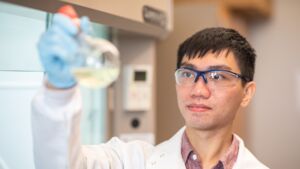
Gaharwar lab is lighting hydrogels via nanomaterials
"Hydrogels are commonly used inside the body to help in tissue regeneration and drug delivery. However, once inside, they can be challenging to control for optimal use. A team of researchers in the Department of Biomedical Engineering at Texas A&M University is developing a new way to manipulate the gel — by using light. Graduate student Patrick Lee and Dr. Akhilesh Gaharwar, associate professor, are developing a new class of hydrogels that can leverage light in a multitude of ways. Light is a particularly attractive source of energy as it can be confined to a predefined area as well as be finetuned by the time or intensity of light exposure. Their work was recently published in the journal Advanced Materials." [...]

Electrochemical cell harvests lithium from seawater
"The system offers an economical way to source essential battery material. Lithium is a vital element in the batteries that power electric vehicles, but soaring lithium demand is expected to exhaust land-based reserves by 2080. KAUST researchers have now developed an economically viable system that can extract high-purity lithium from seawater. The oceans contain about 5,000 times more lithium than the land but at extremely low concentrations of about 0.2 parts per million (ppm). Larger ions, including sodium, magnesium and potassium, are all present in seawater at much higher concentrations; however, previous research efforts to tease lithium from this mixture have yielded little. The KAUST team solved this problem with an electrochemical cell containing a ceramic membrane made from lithium lanthanum titanium oxide (LLTO)." [...]

Probing Deeper into Origins of Cosmic Rays
"Cosmic rays are high-energy atomic particles continually bombarding Earth’s surface at nearly the speed of light. Our planet’s magnetic field shields the surface from most of the radiation generated by these particles. Still, cosmic rays can cause electronic malfunctions and are the leading concern in planning for space missions. Researchers know cosmic rays originate from the multitude of stars in the Milky Way, including our sun, and other galaxies. The difficulty is tracing the particles to specific sources, because the turbulence of interstellar gas, plasma, and dust causes them to scatter and rescatter in different directions. In AIP Advances, by AIP Publishing, University of Notre Dame researchers developed a simulation model to better understand these and other cosmic ray transport characteristics, with the goal of developing algorithms to enhance existing detection techniques." [...]
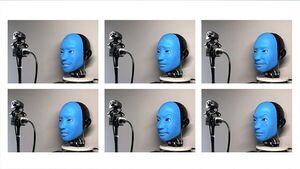
The Robot Smiled Back
"Columbia Engineering researchers use AI to teach robots to make appropriate reactive human facial expressions, an ability that could build trust between humans and their robotic co-workers and care-givers While our facial expressions play a huge role in building trust, most robots still sport the blank and static visage of a professional poker player. With the increasing use of robots in locations where robots and humans need to work closely together, from nursing homes to warehouses and factories, the need for a more responsive, facially realistic robot is growing more urgent. Long interested in the interactions between robots and humans, researchers in the Creative Machines Lab at Columbia Engineering have been working for five years to create EVA, a new autonomous robot with a soft and expressive face that responds to match the expressions of nearby humans. The research will be presented at the ICRA conference on May 30, 2021, and the robot blueprints are open-sourced on Hardware-X (April 2021). “The idea for EVA took shape a few years ago, when my students and I began to notice that the robots in our lab were staring back at us through plastic, googly eyes,” said Hod Lipson, James and Sally Scapa Professor of Innovation (Mechanical Engineering) and director of the Creative Machines Lab. Lipson observed a similar trend in the grocery store, where he encountered restocking robots wearing name badges, and in one case, decked out in a cozy, hand-knit cap." [...]

Why deep freezing iron-based materials makes them both magnetic and superconducting
"Physicists at Bath have uncovered a new mechanism for enabling magnetism and superconductivity to co-exist in the same material. Physicists at the University of Bath, in collaboration with researchers from the USA, have uncovered a new mechanism for enabling magnetism and superconductivity to co-exist in the same material. Until now, scientists could only guess how this unusual coexistence might be possible. The discovery could lead to applications in green energy technologies and in the development of superconducting devices, such as next-generation computer hardware. As a rule, superconductivity (the ability of a material to pass an electrical current with perfect efficiency) and magnetism (seen at work in fridge magnets) make poor bedfellows because the alignment of the tiny electronic magnetic particles in ferromagnets generally leads to the destruction of the electron pairs responsible for superconductivity. Despite this, the Bath researchers have found that the iron-based superconductor RbEuFe4As4, which is superconducting below -236°C, exhibits both superconductivity and magnetism below -258°C." [...]
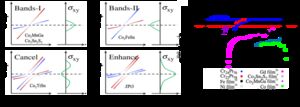
Harmonious electronic structure leads to enhanced quantum materials
"The electronic structure of metallic materials determines the behavior of electron transport. Magnetic Weyl semimetals have a unique topological electronic structure - the electron's motion is dynamically linked to its spin. These Weyl semimetals have come to be the most exciting quantum materials that allow for dissipationless transport, low power operation, and exotic topological fields that can accelerate the motion of the electrons in new directions. The compounds Co3Sn2S2 and Co2MnGa [1-4], recently discovered by the Felser group, have shown some of the most prominent effects due to a set of two topological bands. Researchers at the Max Planck Institute for Chemical Physics of Solids in Dresden, the University of South Florida in the USA, and co-workers have discovered a new mechanism in magnetic compounds that couples multiple topological bands. The coupling can significantly enhance the effects of quantum phenomena." [...]
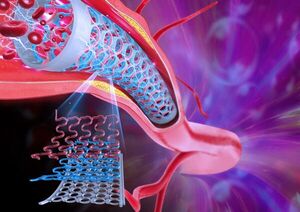
Self-Aware Materials Build the Foundation for Living Structures
"From the biggest bridges to the smallest medical implants, sensors are everywhere, and for good reason: The ability to sense and monitor changes before they become problems can be both cost-saving and life-saving. To better address these potential threats, the Intelligent Structural Monitoring and Response Testing (iSMaRT) Lab at the University of Pittsburgh Swanson School of Engineering has designed a new class of materials that are both sensing mediums and nanogenerators, and are poised to revolutionize the multifunctional material technology big and small. The research, recently published in Nano Energy, describes a new metamaterial system that acts as its own sensor, recording and relaying important information about the pressure and stresses on its structure. The so-called “self-aware metamaterial” generates its own power and can be used for a wide array of sensing and monitoring applications. The most innovative facet of the work is its scalability: the same design works at both nanoscale and megascale simply by tailoring the design geometry. “There is no doubt that the next generation materials need to be multifunctional, adaptive and tunable.” said Amir Alavi, assistant professor of civil and environmental engineering and bioengineering, who leads the iSMaRT Lab." [...]

UArizona Engineers Demonstrate a Quantum Advantage
"In a new paper, researchers in the College of Engineering and James C. Wyant College of Optical Sciences experimentally demonstrate how quantum resources aren't just dreams for the distant future – they can improve the technology of today. Quantum computing and quantum sensing have the potential to be vastly more powerful than their classical counterparts. Not only could a fully realized quantum computer take just seconds to solve equations that would take a classical computer thousands of years, but it could have incalculable impacts on areas ranging from biomedical imaging to autonomous driving. However, the technology isn't quite there yet. In fact, despite widespread theories about the far-reaching impact of quantum technologies, very few researchers have been able to demonstrate, using the technology available now, that quantum methods have an advantage over their classical counterparts. In a paper published on June 1 in the journal Physical Review X, University of Arizona researchers experimentally show that quantum has an advantage over classical computing systems." [...]

Magnetic materials analysis has never been so comprehensible
"Professor Andreas Michels, physicist at the University of Luxembourg, explores the complex world of magnetic materials by shooting neutrons on them. He has now published his insights in a 380-page-thick monograph entitled “Magnetic Small-Angle Neutron Scattering − A Probe for Mesoscale Magnetism Analysis”. The book is published by Oxford University Press. Being the result of more than two decades of experimental, theoretical, and simulation research, Prof. Andreas Michels has now written the first book dedicated exclusively to the specific neutron technique of magnetic small-angle neutron scattering (SANS). “Whenever you want to know where magnetic atoms are located in a material and how they move, you have to use neutron scattering”, says Prof. Andreas Michels. The neutron is an elementary particle which carries a magnetic moment or spin." [...]

3D printing tiny parts for big impact
"Professor Nicholas Fang’s startup Boston Micro Fabrication uses a novel light-focusing method to make ultraprecise printers. Whether it’s computer chips, smartphone components, or camera parts, the hardware in many products is constantly getting smaller. The trend is pushing companies to come up with new ways to make the parts that power our world. Enter Boston Micro Fabrication (BMF). The company was co-founded by MIT Professor Nicholas Fang in 2016 to improve the resolution and precision of 3D printing. Today BMF is helping customers in the race toward ever smaller parts by offering new kinds of printers that are being used to make electronics, medical devices, microfluidic chips, and more." [...]

Light-Shrinking Material Lets Ordinary Microscope See in Super Resolution
"Electrical engineers at the University of California San Diego developed a technology that improves the resolution of an ordinary light microscope so that it can be used to directly observe finer structures and details in living cells. The technology turns a conventional light microscope into what’s called a super-resolution microscope. It involves a specially engineered material that shortens the wavelength of light as it illuminates the sample—this shrunken light is what essentially enables the microscope to image in higher resolution. “This material converts low resolution light to high resolution light,” said Zhaowei Liu, a professor of electrical and computer engineering at UC San Diego. “It’s very simple and easy to use. Just place a sample on the material, then put the whole thing under a normal microscope—no fancy modification needed.” The work, which was published in Nature Communications, overcomes a big limitation of conventional light microscopes: low resolution." [...]
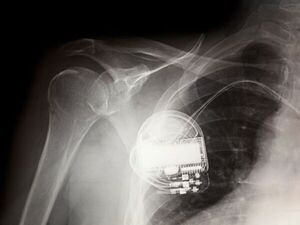
The Powerhouse Future Is Flexoelectric
"Researchers have demonstrated “giant flexoelectricity” in soft elastomers that could improve robot movement range and make self-powered pacemakers a real possibility. In a paper published this month in the Proceedings of the National Academy of Sciences, scientists from the University of Houston and Air Force Research Laboratory explain how to engineer ostensibly ordinary substances like silicone rubber into an electric powerhouse. What do the following have in common: a self-powered implanted medical device, a soft human-like robot and how we hear sound? The answer as to why these two disparate technologies and biological phenomena are similar lies in how the materials they are made of can significantly change in size and shape – or deform – like a rubber band, when an electrical signal is sent. Some materials in nature can perform this function, acting as an energy converter that deforms when an electrical signal is sent through or supplies electricity when manipulated. This is called piezoelectricity and is useful in creating sensors and laser electronics, among several other end uses." [...]
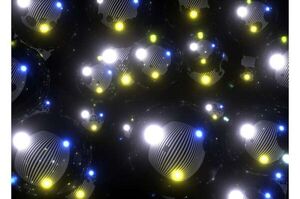
A new dimension in the quest to understand dark matter
"As its name suggests, dark matter — material which makes up about 85% of the mass in the universe — emits no light, eluding easy detection. Its properties, too, remain fairly obscure. Now, a theoretical particle physicist at the University of California, Riverside, and colleagues have published a research paper in the Journal of High Energy Physics that shows how theories positing the existence a new type of force could help explain dark matter’s properties. “We live in an ocean of dark matter, yet we know very little about what it could be,” said Flip Tanedo, an assistant professor of physics and astronomy and the paper’s senior author. “It is one of the most vexing known unknowns in nature. We know it exists, but we do not know how to look for it or why it hasn’t shown up where we expected it.” Physicists have used telescopes, gigantic underground experiments, and colliders to learn more about dark matter for the last 30 years, though no positive evidence has materialized." [...]
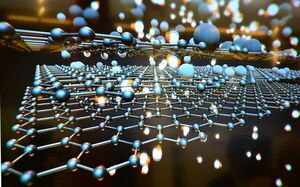
New Method To Improve Durability Of Nano-Electronic Components To Help Further Semiconductor Manufacturing And Resilience
"USF Mechanical Engineering assistant professor Michael Cai Wang’s group recently developed a novel approach to effectively mitigate electromigration, a phenomenon that has long posed challenges for the semiconductor and integrated circuits industry. USF Mechanical Engineering assistant professor Michael Cai Wang and his research team recently developed a novel approach to mitigating electromigration in nanoscale electronic interconnects that are ubiquitous in state-of-the-art integrated circuits. This was achieved by coating copper metal interconnects with hexagonal boron nitride (hBN), an atomically-thin insulating two-dimensional (2D) material that shares a similar structure as the “wonder material” graphene. Electromigration is the phenomenon in which an electrical current passing through a conductor causes the atomic-scale erosion of the material, eventually resulting in device failure. Conventional semiconductor technology addresses this challenge by using a barrier or liner material, but this takes up precious space on the wafer that could otherwise be used to pack in more transistors. Wang’s approach accomplishes this same goal, but with the thinnest possible materials in the world, two-dimensional (2D) materials." [...]
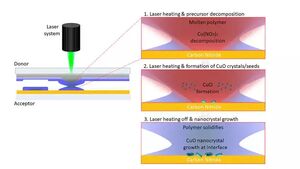
Nanomaterials with laser printing
"Catalysts which generate hydrogen and other substances can be produced more efficiently An interdisciplinary team from the Max Planck Institute of Colloids and Interfaces presents a laser-driven technology that enables them to create nanoparticles out of materials such as copper, cobalt and nickel oxides. At the usual printing speed, photoelectrodes are produced in this way, for example, for a wide range of applications such as the generation of green hydrogen. Previous methods produce such nanomaterials only with high energy input in classical reaction vessels and in many hours. With the laser-driven technology developed at the institute, the scientists can deposit small amounts of material on a surface and simultaneously perform chemical synthesis in a very short time using high temperatures from the laser. ‘When I discovered the nanocrystals under the electron microscope, I knew I was onto something big,’ says Junfang Zhang, first author of the study and doctoral researcher. The discovery turned into a new and environmentally friendly method for synthesizing materials that can, among other things, use solar energy for chemical reaction such as the formation hydrogen." [...]

Engineers create a programmable fiber
"In a first, the digital fiber contains memory, temperature sensors, and a trained neural network program for inferring physical activity. MIT researchers have created the first fiber with digital capabilities, able to sense, store, analyze, and infer activity after being sewn into a shirt. Yoel Fink, who is a professor in the departments of materials science and engineering and electrical engineering and computer science, a Research Laboratory of Electronics principal investigator, and the senior author on the study, says digital fibers expand the possibilities for fabrics to uncover the context of hidden patterns in the human body that could be used for physical performance monitoring, medical inference, and early disease detection. Or, you might someday store your wedding music in the gown you wore on the big day — more on that later. Fink and his colleagues describe the features of the digital fiber today in Nature Communications. Until now, electronic fibers have been analog — carrying a continuous electrical signal — rather than digital, where discrete bits of information can be encoded and processed in 0s and 1s." [...]
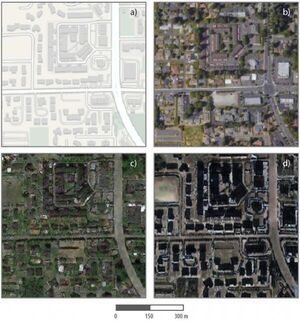
Map integrity: Researchers explore ways to detect ‘deep fakes’ in geography
"Can you trust the map on your smartphone, or the satellite image on your computer screen? So far, yes, but it may only be a matter of time until the growing problem of “deep fakes” converges with geographical information science (GIS). Researchers such as Associate Professor of Geography Chengbin Deng are doing what they can to get ahead of the problem. Deng and four colleagues — Bo Zhao and Yifan Sun at the University of Washington, and Shaozeng Zhang and Chunxue Xu at Oregon State University — co-authored a recent article in Cartography and Geographic Information Science that explores the problem. In “Deep fake geography? When geospatial data encounter Artificial Intelligence,” they explore how false satellite images could potentially be constructed and detected." [...]
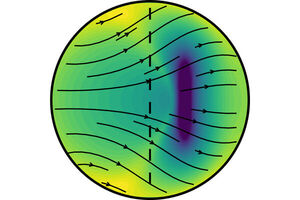
Is Earth’s core lopsided? Strange goings-on in our planet’s interior.
"For reasons unknown, Earth’s solid-iron inner core is growing faster on one side than the other, and it has been ever since it started to freeze out from molten iron more than half a billion years ago, according to a new study by seismologists at the University of California, Berkeley. The faster growth under Indonesia’s Banda Sea hasn’t left the core lopsided. Gravity evenly distributes the new growth — iron crystals that form as the molten iron cools — to maintain a spherical inner core that grows in radius by an average of 1 millimeter per year. But the enhanced growth on one side suggests that something in Earth’s outer core or mantle under Indonesia is removing heat from the inner core at a faster rate than on the opposite side, under Brazil. Quicker cooling on one side would accelerate iron crystallization and inner core growth on that side. This has implications for Earth’s magnetic field and its history, because convection in the outer core driven by release of heat from the inner core is what today drives the dynamo that generates the magnetic field that protects us from dangerous particles from the sun." [...]
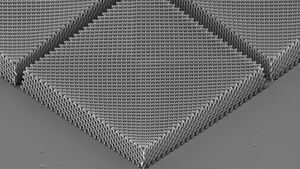
Breakthrough in 3D magnetic nanostructures could transform modern-day computing
"Scientists have taken a step towards the creation of powerful devices that harness magnetic charge by creating the first ever three-dimensional replica of a material known as a ‘spin-ice’. Spin ice materials are extremely unusual as they possess so-called defects which behave as the single pole of a magnet. These single pole magnets, also known as magnetic monopoles, do not exist in nature; when every magnetic material is cut into two it will always create a new magnet with a north and south pole. For decades scientists have been looking far and wide for evidence of naturally occurring magnetic monopoles in the hope of finally grouping the fundamental forces of nature into a so-called theory of everything, putting all of physics under one roof. However, in recent years physicists have managed to produce artificial versions of a magnetic monopole through the creation of two-dimensional spin-ice materials. To date these structures have successfully demonstrated a magnetic monopole, but it is impossible to obtain the same physics when the material is confined to a single plane." [...]

Electrons Waiting For Their Turn: New Model Explains 3D Quantum Material
"Scientists from the Cluster of Excellence ct.qmat – Complexity and Topology in Quantum Matter have developed a new understanding of how electrons behave in strong magnetic fields. Their results explain measurements of electric currents in three-dimensional materials that signal a quantum Hall effect – a phenomenon thus far only associated with two-dimensional metals. This new 3D effect can be the foundation for topological quantum phenomena, which are believed to be particularly robust and therefore promising candidates for extremely powerful quantum technologies. These results have just been published in the scientific journal Nature Communications. Dr. Tobias Meng and Dr. Johannes Gooth are early career researchers in the Würzburg-Dresdner Cluster of Excellence ct.qmat that researches topological quantum materials since 2019. They could hardly believe the findings of a recent publication in “Nature” claiming that electrons in the topological metal zirconium pentatelluride (ZrTe5) move only in two-dimensional planes, despite the fact that the material is three-dimensional." [...]

Phonon catalysis could lead to a new field
"By selectively heating specific phonons without heating the entire material, researchers have enhanced ion diffusion in a way that could have broad applications. Batteries and fuel cells often rely on a process known as ion diffusion to function. In ion diffusion, ionized atoms move through solid materials, similar to the process of water being absorbed by rice when cooked. Just like cooking rice, ion diffusion is incredibly temperature-dependent and requires high temperatures to happen fast. This temperature dependence can be limiting, as the materials used in some systems like fuel cells need to withstand high temperatures sometimes in excess of 1,000 degrees Celsius. In a new study, a team of researchers at MIT and the University of Muenster in Germany showed a new effect, where ion diffusion is enhanced while the material remains cold, by only exciting a select number of vibrations known as phonons." [...]

Developing a new AI early warning system for flooding
"Lancaster University researchers are developing new artificial intelligence systems that could help to predict and warn of flooding. Professor Plamen Angelov leads a collaborative project with the European Space Agency’s Φ-lab to develop a new AI system that will be able to efficiently analyse and interpret streams of satellite imagery and other data in real time. The new system would be able to improve flood alerts and rescue planning. In previous work Professor Angelov, Chair in Intelligent Systems at Lancaster University’s School of Computing and Communications, has developed an ‘explainable’ approach to developing deep learning AI systems, called xDNN. This explainable approach helps to overcome a significant challenge in AI called the ’black box’ problem – where humans cannot understand why an AI system makes a particular decision. This three-year research project, called ‘Towards explainable AI for Earth Observation (AI4EO): a new frontier to gain trust into the AI’, will build upon, develop further and apply Professor Angelov’s xDNN system to images and other data captured by the European Space Agency’s Sentinel satellite programme." [...]

Rochester laser experiments demonstrate ‘helium rain’ likely falls in the solar system
"New research at the Laboratory for Laser Energetics provides clues to the evolution of the solar system. Nearly 40 years ago, scientists predicted the existence of helium rain inside planets composed primarily of hydrogen and helium, such as Jupiter and Saturn. But achieving the experimental conditions necessary to test this hypothesis has not been possible. That is, until now. In a paper published in Nature, scientists at the University of Rochester, together with an international collaboration, reveal experimental evidence showing that helium rain—helium droplets falling through liquid metallic hydrogen, much like raindrops of water falling through the atmosphere on Earth—is possible over a range of pressure and temperature conditions that mirror those expected to occur inside planets such as Jupiter and Saturn. The discovery will help scientists determine how such planets form and will provide key insight into the evolution of Earth and the solar system." [...]

A new water treatment technology could also help Mars explorers
"A team led by UC Riverside engineers has developed a catalyst to remove a dangerous chemical from water on Earth that could also make Martian soil safer for agriculture and help produce oxygen for human Mars explorers. Perchlorate, a negative ion consisting of one chlorine atom bonded to four oxygen atoms, occurs naturally in some soils on Earth, and is especially abundant in Martian soil. As a powerful oxidizer, perchlorate is also manufactured and used in solid rocket fuel, fireworks, munitions, airbag initiators for vehicles, matches and signal flares. It is a byproduct in some disinfectants and herbicides. Because of its ubiquity in both soil and industrial goods, perchlorate is a common water contaminant that causes certain thyroid disorders. Perchlorate bioaccumulates in plant tissues and a large amount of perchlorate found in Martian soil could make food grown there unsafe to eat, limiting the potential for human settlements on Mars." [...]

Australia Leads Project That Will Burst The Hubble Bubble
"Australian scientists will help construct one of the world’s most powerful ground-based telescopes that promises to see further and clearer than the Hubble Space Telescope and unlock mysteries of the early Universe. The team will develop a new, world-first instrument that will produce images three times sharper than Hubble under the multimillion dollar project. The MAVIS instrument will be fitted to one of the eight–metreUnit Telescopes at the European Southern Observatory’s (ESO’s) Very Large Telescope in Chile, to remove blurring from telescope images caused by turbulence in Earth’s atmosphere. MAVIS will be built over seven years at a cost of $57 million. The MAVIS consortium is led by The Australian National University (ANU), and involves Macquarie University, Italy’s National Institute for Astrophysics (INAF) and France’s Laboratoire d’Astrophysique (LAM). MAVIS Principal Investigator Professor François Rigaut, from the ANU Research School of Astronomy and Astrophysics, said atmospheric turbulence is like the phenomenon of objects appearing blurry on the horizon during a hot day." [...]
Projetos Maker
Diversos Projetos interessantes.
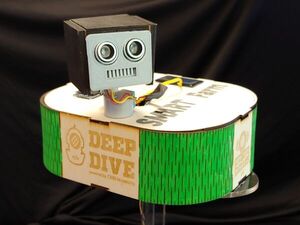
Smart Farming System
"A Smart Farming System that is unlike anything you have ever seen before! Our innovative Smart Farm will deter pests and detect intruders! This innovative smart farm system will alleviate the tedious but crucial work that farmers all over the globe suffer from. The system will be able to communicate with the farmers anywhere that there is a smart device with Bluetooth capabilities. In comparison to previous farming systems, this smart farming system is the tesla of farming systems because it utilizes the newest in cutting edge technology in order to boost yields and maintain farmer morale! The PURPOSE of this project came about because of real-life experiences during New Mexico’s first hemp farming season in 2019." [...]
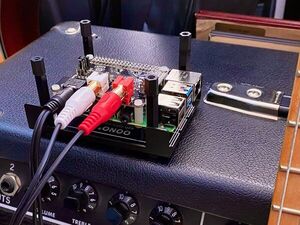
NeuralPi: Raspberry Pi Guitar Pedal with Neural Networks
"NeuralPi is a Raspberry Pi guitar pedal using neural networks to emulate real amps and pedals. NeuralPi was created out of a curiosity for machine learning and a passion for great guitar tone. I had developed several guitar plugins that use machine learning/neural networks, each building on what I had learned from the previous one. I had always had the idea of using this software to build a guitar pedal in the back of my mind. When I started digging into it, I found that much of the groundwork had already been done to make this a reality. Using Elk Audio OS, a low latency Linux based operating system, I was able to convert my already developed neural network plugin into stand-alone guitar effect running on the Raspberry Pi 4." [...]
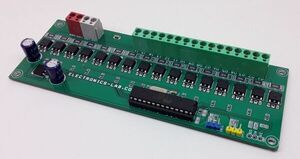
Automatic LED Stairway Lighting – Arduino Compatible
"This creative idea is suitable for a stairway with 16 stairs, each stair can have a 12V LED. It has two sensors one at the start and one at the end of the stairs and when the sensor trigered at any end it starts a process of lighting each of the steps in a progressive cycle starts. When you reach the other side of the stairway and the second sensor is triggered it will start to extinguish all the lit lights in the ascending cycle. This is a very simple and easy to build project based on the Arduino platform The board consists of an ATMEGA328 microcontroller, 16 channel MOSFETs, 2 optical retro-reflective or optical defuse sensor, 16 x 12V LEDs, LM7805 regulator, DC filter capacitors, and optional current limiting resistor on each MOSFET. The circuit requires 12V DC, each MOSFET can drive a LED up to 1A (0.5 to 12W LED) LEDs: Each MOSFET can drive LED of 0.5W to 12W, it is advisable to use 12V LEDs, use appropriate current limiting resistors (R3, R15, R23, R31, R7, R17, R25, R33, R11, R19, R27, R35, R13, R21, R29, R37) if lower voltage LEDs is used. The default value for these resistors is 0 Ohms." [...]
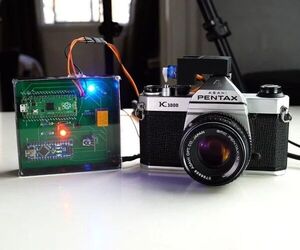
Remote Shutter Circuit : Pentax K1000 Film Camera
"Ill be using the Raspberry Pi PICO to make a infrared remote shutter for an old film camera. This is the equivalent of a simple remote shutter operated by a small button you might use on a dslr camera, or even a remote trigger button that came with your tripod. To show you how this works the basic operation of this circuit can be defined in 3 steps 1. The Button on the infrared remote is pressed 2. The circuit turns on 3. The servo moves and makes the camera take a picture There is however a little more going on behind the scenes that makes it work but that's the simplified version." [...]
Tiny MIDI controller with Raspberry Pi Pico
"With a MIDI library available for the Raspberry Pi Pico making a little MIDI “piano” is relatively easy. The MacroPad which I build last month is the perfect little device to play around with this. If you are interested in how to connect buttons and LEDs to a Pi Pico, check out that post here! A MIDI controller behaves different from a USB keyboard; once a key is pressed it generates a MIDI signal that can be picked up by a compatible instrument or software to produce a sound. The signal contains the note that needs to be played, but can also contain the velocity (how fast/hard a key is pressed). Furthermore, it is possible to send signals to bend notes, set the volume of an instrument, … Keys also don’t repeat after being pressed longer." [...]

Predicting Solar Panel Voltage output with AI
"In this project, we will be using SensiML and QuickLogic QuickFeather to predict Solar Panel Voltage at different irradiance levels. Story Great minds worked in coordination to create this essential asset for the human race. Development and generation of electricity changed the lives drastically, starting from domestic use to industrial activities. Despite its great importance in daily life, few people probably stop to think about what life would be like without electricity. Like air and water, people tend to take electricity for granted. Non renewable resources and renewable resources are used to generate electricity but non renewable resources cannot be replaced and release carbon dioxide and other greenhouse gases when they are burned to produce electricity." [...]
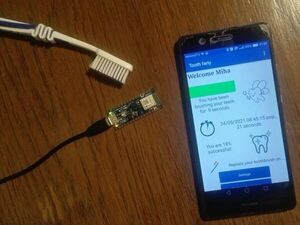
Tooth fairy
"Detecting when a user is brushing their teeth and encouraging them to do so. Story Pitch Ever worried whether or not you brushed your teeth thoroughly enough? Have you ever wandered off with your thoughts and forgot about the time, suddenly being uncertain if you've been brushing for 30 seconds or 5 minutes? And have you ever forgotten whether or not you brushed your teeth last night? Worry no more, the tooth fairy's got you covered. With this combination of an app for your phone and code for your Arduino Nano 33 BLE Sense you can now be worry free too." [...]

Arduboy Home
"Play Arduboy games on the big screen with the Arduboy Home game console. The tiny OLED display of the Arduboy has been replaced with VGA output, and the Home has a separate, handheld controller. The home console is compatible with the existing Arduboy game library. An Arduboy game is compiled and loaded onto an Arduino Micro. The compilation uses an Arduboy2 library that I modified to support VGA output. Only the library has been modified—games are compatible without change." [...]
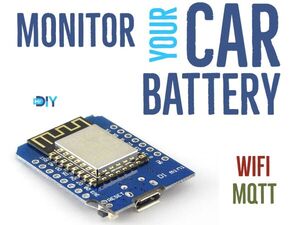
Monitor Your Car Battery: Code & Setup
"This is how I monitor my car battery remotely over Wifi using this DIY device costing only couple of dollars. Having the ability to monitor your car battery can prevent some unpleasant surprises. I will show you how I assembled the hardware, loaded the software and installed the monitor in my car. I will be using the ESP8266 Board called Wemos D1 Mini. " [...]

DIY Non Contact IR Thermometer V1.0
"Currently, we are chasing an invisible monster named Corona Virus ( COVID-19 ) and we are going through the biggest health crisis in our time due to a sharp increase in infection cases. One of the main symptoms of the COVID-19 infected person is an increase in body temperature, in addition to other symptoms such as pain in the body, difficulty in breathing. It is very essential to monitor continuously the body temperature to detect a corona patient at a very early stage so that proper medication may be taken for fast recovery. The normal IR thermometer can measure the temperature of a covid patient and also may spread the virus. The main drawback of the handheld thermometer is its performance depends on the operator and the distance to the forehead. To address these problems, a device is made that can be mounted on the wall for fever screening in public areas without an operator." [...]
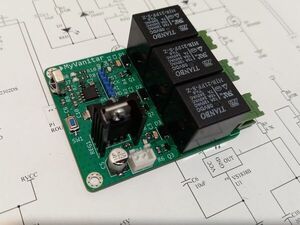
Infrared Remote Control Decoder & Switcher using Arduino
"Infrared Remote Control Decoder & Switcher using Arduino Story Infrared remote controllers are everywhere around us. The majority of home appliances are controlled using infrared remote controls. In this article/video, we learn to build a device that can decode (almost) any IR remote control and use the instructions to switch the relays (loads). So we can use this feature in a variety of applications without buying a new IR remote control and expensive hardware, such as turning ON/OFF the lights, opening/closing the curtains,... etc. I have used an ATTiny85 microcontroller as the heart of the circuit. The device can record up to three IR codes in the EEPROM memory and switch 3 separate devices." [...]
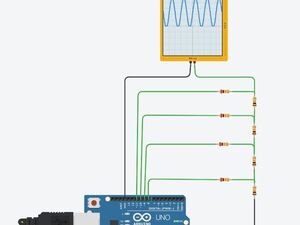
UART Controlled Arduino UNO signal generator
"Real Time Digital signal processing: UART Controlled Arduino UNO signal generator In this project, the goal is to write a skech for Arduino Uno which will enable to produce (by using 4 bits R2R DAC) the following Analog signals: 1) Sin wave 2) Sawtooth wave 3) Dumped cosine wave A- Amplitude in Volts in the range [0-5] [V] F- Signal frequency, F=1/T (T- period in seconds, created signal must contain 64 counts per period) B- Amplitude of the Pseudo-random flat noise (in the range [0-5] [V]) C- Number of positive bumps per period T with amplitude 1V, C is in the range [0-5][V]" [...]
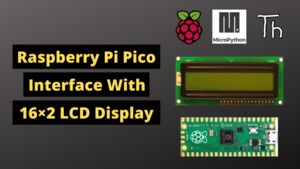
Raspberry Pi Pico with 16X2 LCD Display
"In this article we are going to interface Raspberry Pi Pico with 16X2 LCD Display If you are new to Raspberry Pi Pico and wants to get started then click here. here you can learn the basics of how to start with raspberry Pi Pico. Required Components List of required components is given below. Raspberry Pi Pico 16*2 LCD Display with I2C Jumper Wires Bread Board" [...]
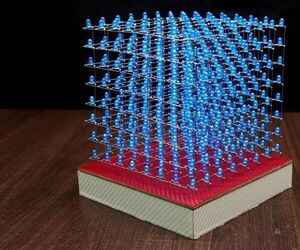
How to Build 8x8x8 LED Cube
"An 8x8x8 LED cube is a visual treat with 3D effects and patterns. It works on the concept of Persistence of Vision, a feature of the human eye which tricks our brain in to thinking that an object is present permanently at a place if it appear about 60 times in a second. Since an 8x8x8 LED Cube consists of, well 8x8x8 = 512 LEDs, we cannot control all these 512 LEDs at once. What we can do is control 64 LEDs at a time at an extremely fast rate and trick our brain as if we were controlling all the 512 LEDs. This LED Cube will light up any party. Your friends will be mesmerized by its hypnotic effect as lights dazzle and dance in brilliant patterns." [...]

PALPi Retro Game Console
"Hey everyone what's up! So this is my RecalBox based handheld gaming console aka the PALPi Its name is PALPi because it uses a composite PAL Display. When I was little I love playing games like Pokemon, contra, super Mario, Final Fantasy, and other games mostly on Gameboy advance and that game console that we hooked up with our CRT TVs to run great old stuff. Well, nowadays we can just download the retro game ROM and open it up in an emulator and play that game on our laptop and mobile devices. But as a maker, I wanted to do something different, so I prepared this handheld retro gaming console setup which is powered by a Raspberry pi zero, the OS that I'm using here is the Recalbox os. It's a decent Emulator OS that also comes with few preloaded games." [...]
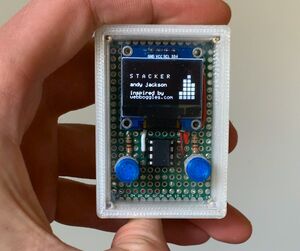
ATtiny Game Boy
"This is my version of a mini game console based around the ATtiny85 microcontroller. There are countless iterations of this type of game console utilizing an ATtiny chip that you can find online. I had a few of these chips laying around after finishing my previous project, Pocket Dice! and wanted to make my own! In my version, my goal was to celebrate the simplicity of the circuit by displaying it in a "see-through" case. Many versions utilize a custom PCB, but I thought it would be awesome solder all of the connections by hand and see them in the final product." [...]

DIY heart rate monitor and pulse oximeter
"DIY heart rate monitor and pulse oximeter using MAX30100 Pulse Oximeter Heart Rate Sensor Module. Story India is badly hit by the second wave of COVID 19. There's a shortage of pulse oximeters. I and my family got infected with COVID 19 and couldn't find any Oximeters for a reasonable price anywhere. So I searched the internet to find any DIY solution and came across this cheap MAX30100 pulse oximeter and heart rate sensor module. General Description ofMAX30100:- The MAX30100 is an integrated pulse oximetry and heart rate monitor sensor solution." [...]

Arduino UV index meter
"UV index meter using GUVA-S12SD. In this project I'll show you how to make a UV index meter which can show the UV index and the UV state using GUVA-S12SD UV sensor. About the Sensor GUVA-S12SD is a Gallium Nitride Based Schottky-type Photodiode. It has a typical UV detection wavelength of 240-370nm(which covers UVB and most of UVA spectrum). It outputs a calibrated analog voltage which varies with the UV light intensity. So, we can read the analog value via Arduino ADC." [...]

DIY 3V to 5V booster with 18650 battery
"If you have a reason not to using booster module, then here is it. some time you want to using 18650 battery for your project, but the some of them require 5v input to work. you just want to design a circuit with the very little power from the power source. note: the circuit using resistor pot to control voltage output, so you must turn resistor pot util you get desired output voltage before connect your module to +5v mark from circuit. " [...]
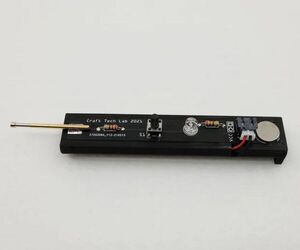
E-Textile Logic Injector - Debugging Tool
"The e-textile logic injector tool enables the injection of a high (1) logical state into a digital circuit. With this tool, makers can simulate a digital write high (digitalWrite (pin, HIGH)) before writing any code. This enables them to test their circuitry for shorts, loose connections, and polarity before adding complexity through code. To use the tool, disconnect your microcontroller from power (recommended), then attach one alligator clip to your board's GND pin and the other clip to the magnet on the logic injector. Press the probe against any thread that you want to inject a signal into and then press the button on the logic probe to test the component (video). This material is based upon work supported by the National Science Foundation under Award #1742081." [...]
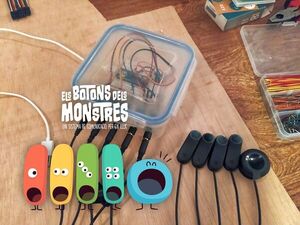
Adaptive Button Keyboard for Kids with Muscular Conditions
"A simple 5 button USB keyboard using Logitech Adaptive Gaming Kit for kids with muscular conditions like myopaty or muscular dystrophy. Story I'm the father of Lluc, a little boy with myotubular myopathy, a severe muscular disease that drastically weakens the motor muscles. This means that Lluc cannot walk or sit still. He needs a ventilator to breathe through a tracheostomy 24 hours a day. Because the tracheostomy enters below the vocal cords, Lluc cannot speak or make sounds. We use his own sign language, adapted to his condition, but we are also looking for a system so that he can speak 'out loud'." [...]

Home automation using Keypad
"From controlling the room lights to controlling the door lock with your keypad, home automation has taken convenience to a whole new level. As thefts are increasing day by day security is becoming a major concern nowadays. I wanted to design something to be able to secure any type of items that you would want to store. Many of us like to control each and every appliances of our home using touchpad, keypad or through Bluetooth. From controlling the room lights to controlling the door lock with your keypad, home automation has taken convenience to a whole new level. Instead of using mechanical switches, you can now continently control all the devices in your home from your fingertips." [...]

Raspberry Pi Pico Matrix Touchscreen Keyboard
"Matrix Keyboards are awesome when it comes to controlling your PC (or even phone and tablet). One push of a button can start a macro, speeding up your workflow. And those keyboards are widely available. But what if you could build one yourself? And you want a touchscreen? Well... that is simple!" [...]

OP Amp IC Tester
"There is nothing more satisfying then building a circuit and having it work as you intended and nothing so infuriating at it failing and not knowing why! There’s usually a few main culprits that can cause a circuit to fail. There could be a solder bridge or a part missing, maybe you have wired something up incorrectly. All these types of failures can be checked, identified and fixed, but what happens if it’s the IC that fails and how do you check if it is working as it should? If you use an IC socket, then you could remove the IC and replace with another. The problem though is, you still wouldn’t know if the IC’s faulty or not." [...]
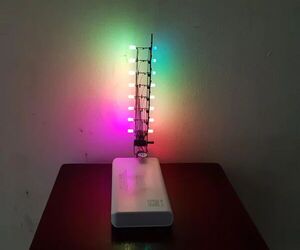
Rainbow Led Circuit Sculpture
"Today I would like to share how to make a sculpture circuit that controls 16 RGB leds using ATTINY85. We can adjust their colors separately according to the colorwheel rule with a touch button. The main components are as follows: 1pcs x DigiSpark ATTiny85. 1pcs x Shift Register 74HC595N. 1pcs x Power Logic 8-Bit Shift Register TPIC6B595N. 8pcs x Transistor A1013." [...]
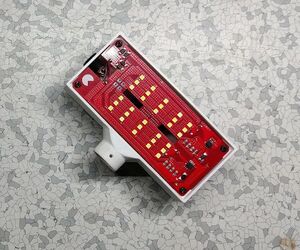
DIY Studio Light/ Light Box
"This is my DIY Studio Light Project Which basically is a do-it-yourself studio light that is made from a custom 3D Printed body and a custom PCB which were both provided by PCBWay. Question Is it better to Buy an expensive Studio Light or Make your own DIY Studio Light with custom 3D Printed parts and PCB? Well, the goal for making this project was just that, I wanted to make a DIY Studio Light for my current "Maker Setup" as the lighting in my lab bench is not very great. Commercially available light costs above 50$ (good ones) but why spend money on them when you can make your own Studio Light, Body can be made from a 3D Printer and the circuit can be manufactured by a PCB manufacturer. In this Instructables, I'm gonna show you guys how I made this DIY Studio Light in few easy steps. Let's Get started!" [...]

Interfacing SSD1306 Based I2C 128x64 OLED Module With ATtiny85 Without Frame Buffer in Assembly Code
"First of all, this is not another Arduino Sketch or Project. The Assembly Language fascinates me and I am using it to write codes for different Industrial control solutions. Previously, I did not work with any Graphic Display modules. Getting some leisure time due to lockdown, I started playing with this cheap OLED module. Initially, I started the project using ATmega32A but migrated to ATtiny85 to lower its power consumption for being able to run it through 4-20mA current loop found in the industries. The following components have been used to build the project: Electronic Components: SSD1306 128x64 I2C OLED Display Module - 1 no." [...]
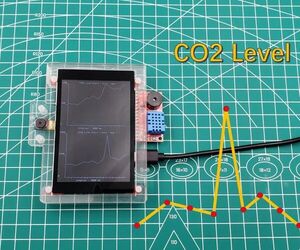
Show CO2 Historical Level Curve With ESP32
"Once I had made a project about the CO2 monitor that had such a problem. The displayed value changes too frequently and fluctuates greatly, which makes it impossible for me to accurately judge the CO2 level. I have a point to make it better nowrecord the history level and draw its to a line. For a parameter that is very easy to cause change with a significant range, it makes no meaning to check the level at a certain moment. Like the CO2 level, a very high concentration may be reached at this moment, but it may return to normal in the next moment in a certain area. Usual temperature and humidity in the air are measured by checking the current value, but the CO2 concentration measurement is different." [...]

How to control 16x16 WS2812 Led Matrix with Smartphone
"This is variation of GyverMatrix project, and In this case, a Wi-Fi network is used instead of Bluetooth This time I will show you how to control adressable led matrix 16 on 16 with smartphone. This is variation of GyverMatrix project, and In this case, a Wi-Fi network is used instead of Bluetooth. Now there is no need to use a real-time clock module because the time is synchronize with NTP server over the Internet. There is also no need for a Bluetooth module because the connection is made through the Wi-Fi network. So the device is extremely simple to build and contains only a few components: - The microcontroller unit is NodeMCU, ESP8266 or Wemos D1 which contain large amount of memory and WiFi on board. In my case it is ESP8266." [...]

Floating Water Quality Sensor
"The aim of this project is to determine the effect of climate change on river water quality. The turbidity of a river tend to change significantly during a period of heavy rainfall. Climate change causes shifts in the air and ocean currents, which causes drastic changes in rainfall patterns. Due to this, the water quality of rivers can change abruptly throughout the year. These unpredictable changes in turbidity can massively increase the cost of drinking water treatment. This project aims to determine how rainfall patterns coincide with the turbidity and turbulence of a flowing body of water, by using a floating sensor." [...]

Puppi
"PUPPI is a tiny, portable, edge ML device ready to interpret a dogs' mood based on vocal signals A dog is man's best friend. But more often than not, the relationship isn't bilateral. A true friend listens, and with PUPPI we are planning to enable that for more people than ever before.For the longest of times, guide dogs have been a pillar onto which people with all kinds of disabilities have been able to support themselves with. But specifically for the hearing impaired, the primary method through which a dog communicates with us is out of the picture.PUPPI is a tiny, portable and easy to use device, meant to identify a dog's different moods through sound analysis. Puppi is small enough that it can be carried clipped onto one's shirt, or even attached to your guide dog's collar. Our app's easy-to-use interface categorizes different moods in a fast and intuitive way, giving the user not only the possibility of quickly gauging the detected stimulus, but also to determine how confident our model is in its decision.The project is spearheaded and mentored by our lecturer at the University of Electrotechnical Engineering, Luka Mali." [...]
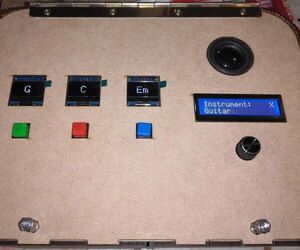
Music PlayBox - ITTT
"HKU Assignment Welcome to my "If This Then That" Project. For this project I made a simple music box where you can play several chords of instruments. You can choose which instrument you want to play (piano/guitar) and which chord you want to play per button. In this instructable I will show you my concept, iterations and a short reflection. I will also share an electronic scheme and the code with explanation. Supplies - Arduino Uno R3 - Small Sized Powerbank - Laser Cutted 3mm MDF Box (MakerCase.com) - 1k Ohm Resistor - YX5200 DFPlayer Mini MP3 Module - TCA9548A I2C Multiplexer - 2 x 8 cm Experiment Print (Islands) - Jumper Cables - 20 cm Tinned Cables - 3 x 0.96 Inch OLED 128 x 64 pixels I2C Display - 1602 LCD I2C Display - Small Wooden Planks - 3W 40mm Speaker - Rotary Encoder KY-040 - 3x Mini Pressure Switch - Piano Hinge - Screws / Bolts / Nails" [...]
Secção Videos
Videos interessantes.
That's all Folks!



